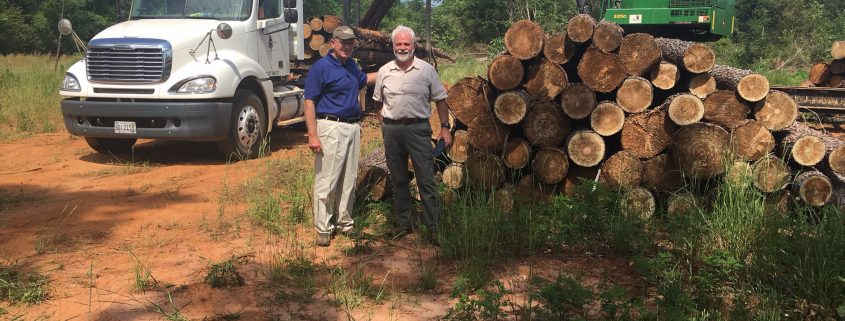Pirtle Forestry Services
John Pirtle served as my Special Projects Forester 1981-84, when I was Land Manager for Union Camp Corporation’s (UCC) Alabama operations. The Company owned (and managed) 500 square miles of forestland across 32 Alabama counties in Central and South-Central Alabama. Thirty-three years after leaving UCC for my doctoral studies, and serving since then at eight universities, three as CEO, I visited May 18 with John back in Prattville, AL (200 miles south of here), where Judy and I lived during my UCC Alabama tenure.
What a joy to see John again — certainly, neither of us had changed! Well, maybe a little gray here and there; a few added and redistributed pounds; a little slower moving; a new ache or two. Most importantly, we reconnected as though we had shared coffee just the week before. The beauty of a good friendship in the face of a third-of-a-century absence.
We visited a logging operation on a property John manages. A quarter century ago, the landowner had harvested and replanted to loblolly pine. The current composition is mixed pine and assorted hardwoods; the planted pine had not entirely captured the site. Pine mortality is now common across the stand, hence leading John to recommend this harvest and subsequent regeneration, before the stand loses additional value. Please keep in mind that a twenty-five-year rotation (the time between planting and harvest) in this climate on these soils is not unusual. John considers this a “mature” stand. He will prescribe (yes, just like a doctor) establishing post-harvest a species mix that he believes will be better suited to this site. I want to revisit and watch his plans unfold.
Interestingly, that morning John reported a little friction with the landowner (I’ll refer to him as Mr. Smith), who fussed at John. The logging crew had just returned to resume harvesting, three months beyond John pulling them when heavy February rains fell. John saw then that continuing the logging would have ruined the access road and harmed the site’s sensitive soils. John knows that the soil is the engine that drives site productivity. Degrade the site by logging when too wet, and the future is diminished. What disturbed Mr. Smith? That morning when he visited the resumed operation, Mr. Smith saw that when John reassigned the crew in February, they had left three truckloads of saw-logs on the deck. After three months, the logs no longer met the fresh-cut quality that sawmills demand, thus relegating the loads to selling as pulpwood… a 70-percent reduction in revenue.
John mollified Mr. Smith by explaining that bringing out the three loads then would have severely damaged the haul road, and could have destroyed the dam berm over which the road exited. John’s February decision had likely saved Mr. Smith road and pond damage many times the value lost in delaying extraction. A forest enterprise, like every business, necessitates decisions that involve trade-offs. No business is as purely Nature-based as forestry and logging, yet the operator of every business and enterprise can glean wisdom from Nature. Mr. Smith wisely retained John, who has monitored, learned, and applied Nature’s wisdom and inspiration for four decades. John harnesses that wisdom and knowledge in service to meeting Mr. Smith’s management objectives, both short-term and long.
Forestland Legacy Stories
John and I hatched plans for me to spend additional time with him. I would have loved walking the property with John and Mr. Smith, seeing, hearing, and discerning more about the land and Mr. Smith’s passion and drive for forest stewardship. I am sure this property has a Story to tell — a Forestland Legacy Story with its own lessons from which we all might learn. I just revisited my March 15 and 23, 2017 Great Blue Heron essays reflecting on my less-than-full-day-visits to Westervelt and Rock City, from which I drew related Forestland Legacy Stories.
The quick visit to Mr. Smith’s land sparked an idea, and is leading me to develop and offer a new Great Blue Heron product. Alabama alone has 23 million acres of forestland; well over half of that acreage is owned by individuals like Mr. Smith. Individuals with a deep and lasting passion for the land. Owners whose tenure reaches back, in some cases, multiple generations, as well as new owners whose stewardship will extend forward to children, grandchildren, and beyond.
Mr. Smith has a detailed forest management plan, prepared by John. That forest management plan is a necessary part of the Story, yet it is just one component. The entire Story reaches far beyond the technical forestry and wildlife management implications. The complete Story involves key elements that reach back, not just extend into the future. The Story reflects far more than management objectives, harvesting plans, boundary lines, prescribed burning, and planting. The Story entails interpreting the land through the lenses of mind, body, heart, spirit, and soul. These Stories are worth telling. Forestland Legacy Stories — a gift to those generations who will steward the land into the future.
[A note as I hit “Publish” for this blog five days after visiting the site: I just heard on The Weather Channel that the broad Montgomery area has recorded over eight inches of rain since we visited Mr. Smith’s property! So much for the best laid plans. I am sure John entered full scramble mode to adjust operations. Experience, I have heard and learned, is that thing you get right after you needed it — John has dealt with such weather vagaries often, leaving Mr. Smith’s property in able hands.]
Featured Image Notation: John and I standing at the active logging deck on Mr. Smith’s property.



